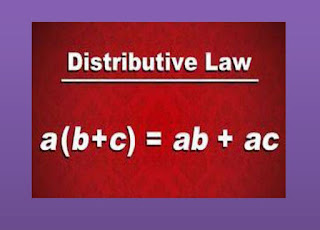LESSON PLAN OF DISTRIBUTIVE LAW
LESSON PLANNING OF DISTRIBUTIVE LAW
Subject Mathematics
Grade 5th
Students` Learning Outcomes
- Verify Distributive Laws
Information for Teachers
- Distributive law collects multiplication and addition subtraction operations;
- o Distributive Law w.r.t addition x(b + c) = a
x b + a x c
- o Distributive law w.r.t subtraction a x ( b –
c) = a x b – a x c
- While teaching the lesson, the teacher should consult textbook at all steps where in and whenever applicable.
Introduction
- Write ‘Distributive Laws’ on the top of the board.
- Ask students if they have any idea what it is?
- Tell students that this law (sometimes called property) states that you get the same answer when you multiply a number by a group of numbers added together as when you do each multiplication separately, such as; 3 x (2 + 4) = 3 x 2 + 3 x 4 so the “3” can be “distributed” over the “2 + 4” into 3 times 2 and 3 times 4.
- Show it with help of the following figure:
- Repeat this activity for subtraction.
Development
Activity 1
- Draw the following shape on the board and tell students that this figure represents the area of rectangle with length b + c and width a.
- Hence area of this rectangle is = a x (b + c) or a( b + c)
- This can be split into two parts as follows;
- Now the sum of the area of both rectangles is a b + a c because both are parts of that rectangle, so we can write; a (b + c) = a b + ac
- Give paper strips to students in groups to verify it for themselves.
Activity 2
- Tell students that it is very convenient to use distributive law for quick multiplication.
- Tell students that I want to multiply 12 x 19, and I used a quick method to do it. I multiplied 12 by 20. Well 12 x 20 is easy, it`s 240. But, I added one more 12 than I needed, so i`ll take it away from 240 to give me 228. =
- Similarly ask students how to do;
4 x 27
= 4(20 + 7)
= 4(20) + (7)
= 80 + 28 = 108
- Solve 2 more examples.
Activity 3
- Now divide students in two groups.
- Each group will suggest a multiplication sum like given in the examples of previous activity, for the other group as challenge.
- Other group will solve in their notebooks.
- Each group will solve at least 5 questions.
- Help students if they are unable to do any question.
- These multiplication sums can be selected from textbook exercise as well.
Sum up / Conclusion
- The Distributive Laws lets you multiply a sum by multiplying each added separately and then add the products.
- Quick multiplication can be done through distributive laws.
- The Distributive Property helps with mental math.
- A quick multiplication is;
4 x 53
= (4 x 50) + (4 x 3)
= 200 + 12 = 212
Assessment
- Students will be given following statement questions to apply their understanding of Distributive Law.
Follow up
- Assign some questions from textbook to do as homework.













Comments
Post a Comment